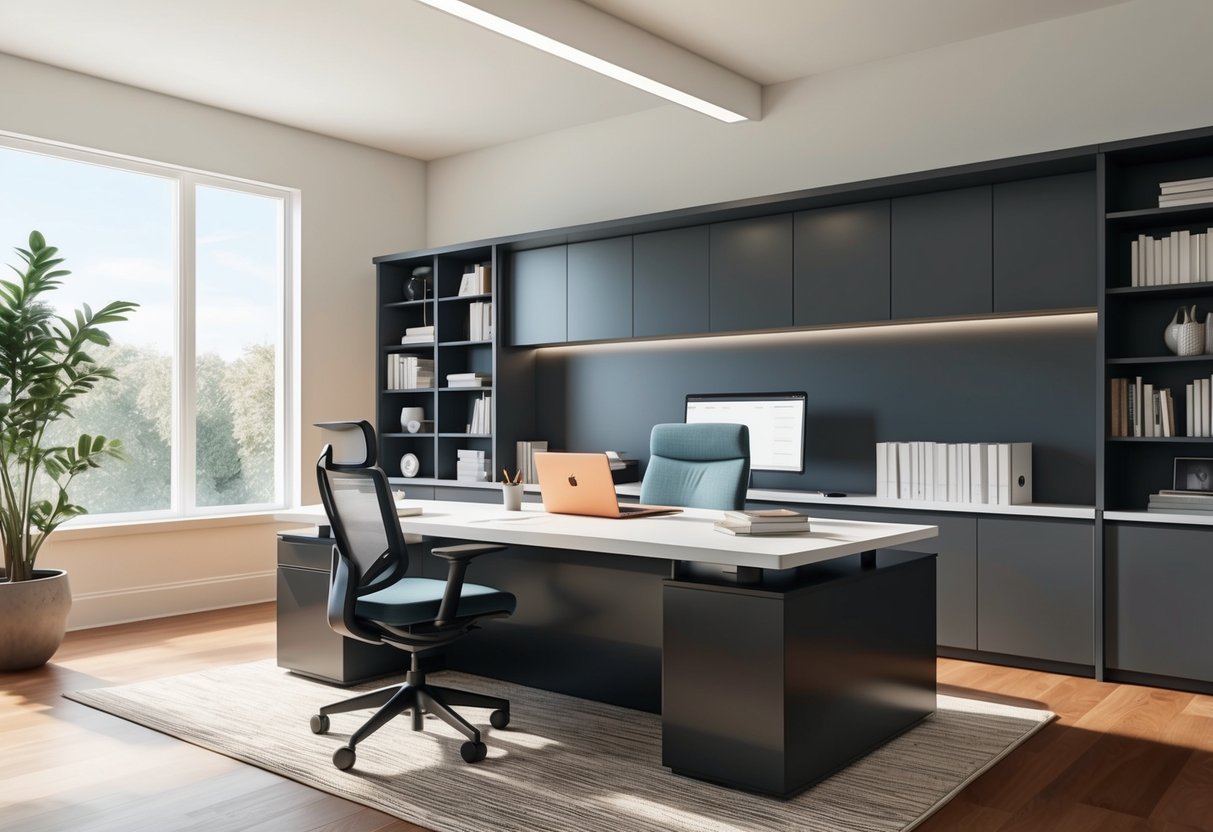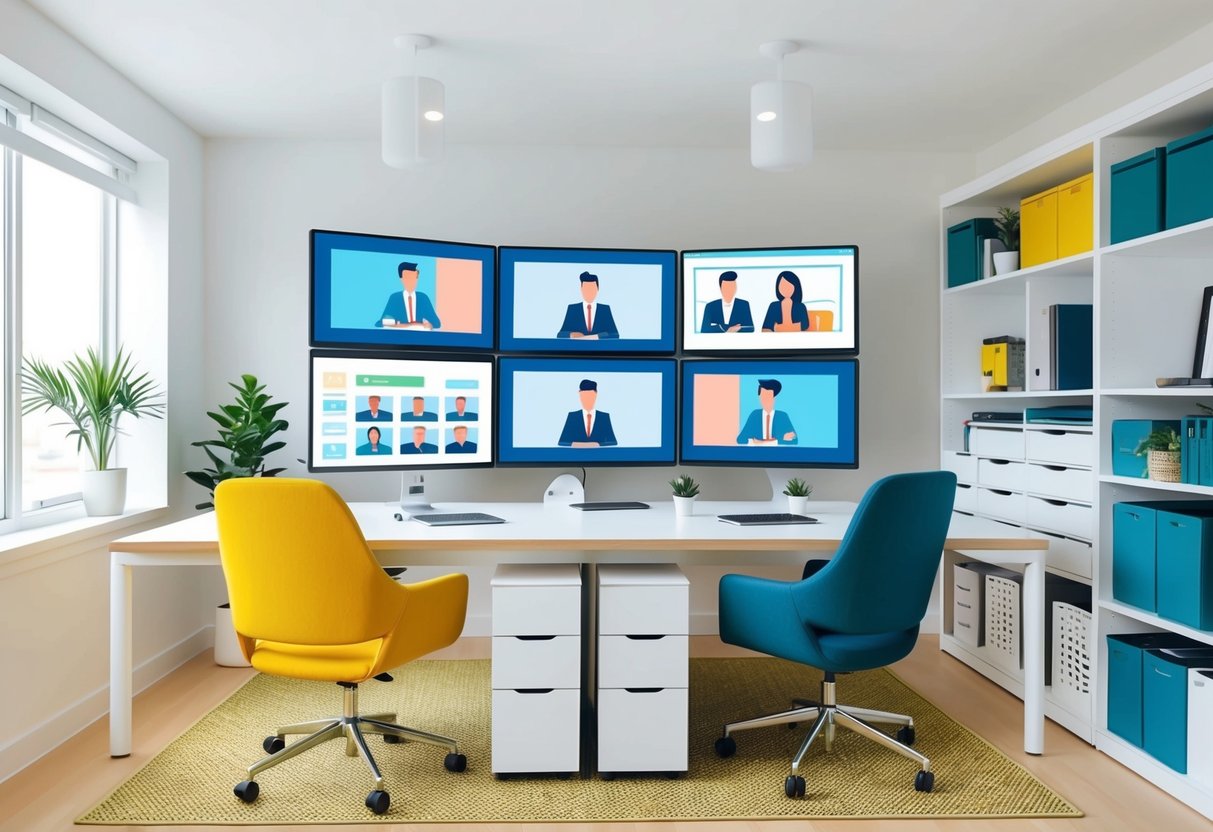
Collaboration and Virtual Meeting Spaces

A productive home office supports both focused tasks and seamless teamwork. Setting up intentional meeting spaces and technology-ready areas for virtual collaboration makes remote work more effective.
Creating Dedicated Meeting Areas
Designating a specific spot for meetings—whether in-person or virtual—enhances both structure and productivity. This could be as simple as a small table with comfortable chairs or a sectioned-off area within the existing workspace.
Key features, such as acoustic panels or carpets, reduce background noise and keep conversations clear. Adding whiteboards, corkboards, or digital collaboration screens encourages brainstorming and real-time idea sharing.
These elements are useful for both formal and casual team interactions. Good lighting and organized furniture support easy transitions between individual work and group activities.
Comfort and accessibility matter, too. Ergonomic seating and a clutter-free surface keep everyone focused on the work at hand.
Flexible setups, like movable dividers, help adapt the meeting area for different group sizes, supporting collaborative work without sacrificing privacy.
Optimizing for Video Calls
A home office designed for virtual meetings benefits from high-speed internet, noise-canceling microphones, and reliable webcams. Positioning the primary setup near natural light enhances video quality, but adjustable LED lamps help maintain clear visuals during any time of day.
Background distractions are minimized with simple décor, neutral colors, or dedicated virtual backgrounds. Display placement should keep the camera at eye level for a professional appearance.
Using headphones or wireless earbuds helps prevent audio feedback and keeps sound focused. Technology should be easy to access and use.
Cable management tools, charging stations, and accessible power outlets keep devices ready for uninterrupted teamwork. Setting up a calendar or visible clock helps users respect time zones and scheduling when coordinating meetings with distributed teams.
Frequently Asked Questions
A well-designed home office prioritizes functional layouts, modern design details, efficient use of space, and practical furniture choices. Integrating design inspiration from sources like Pinterest or the corporate world can result in a personalized workspace that balances productivity and comfort.
What are some simple yet effective home office layouts to enhance productivity?
A linear desk setup against a wall is ideal for single-monitor users and limits distractions. For those needing more surface area, an L-shaped desk maximizes usable corner space and separates work zones.
Those sharing a workspace may benefit from back-to-back or side-by-side desks with privacy panels to minimize interruptions. Standing desk configurations can also support active work habits.
Including shelving above or beside the desk keeps essential items close at hand without crowding the desktop.
How can I incorporate modern design elements into my home office to improve focus?
Integrating clean lines, neutral or muted color palettes, and minimalistic accessories contributes to a calm workspace. Glass-top desks, ergonomic chairs with sleek silhouettes, and streamlined task lighting offer both style and function.
Incorporating acoustic panels, textured wall coverings, or natural wood accents can enhance the sensory environment and reduce visual clutter. Subtle pops of color—like a bold chair or artwork—add personality without overwhelming the space.
What are the best strategies for optimizing a small home office space for productivity?
Using vertical space with wall-mounted storage, floating shelves, or pegboards keeps the floor area open and organized. Fold-down desks or compact writing tables help maintain ample room for movement.
Choosing light colors and mirrors can make the workspace appear larger and more inviting. Multi-functional furniture, like filing cabinets that double as side tables, reduces clutter.
Monitor arms or risers free up desk space and promote better ergonomics, which is important for staying productive in tighter quarters. For more tips, see this home office setup guide.
Which IKEA furniture pieces are ideal for creating a productive home office?
The IKEA BEKANT and IDÅSEN series offer height-adjustable desks, giving users the flexibility to alternate between sitting and standing. The ALEX drawer unit is a popular choice for compact storage of paperwork and office supplies.
For seating, the MARKUS chair is well-reviewed for comfort and support during long work sessions. The KALLAX shelving unit can serve as book storage or a room divider in multifunctional spaces.
How do I use Pinterest inspiration to design a home office that promotes focused work?
Pinterest is a valuable resource for visualizing desk arrangements, color schemes, and creative organization solutions. Users can collect images of modern home offices and identify recurring elements such as specific lighting types, storage hacks, or desk styles that align with their needs.
Replicating these ideas often involves DIY projects, like customized cork boards or upgraded lighting, enabling a tailored workspace that blends aesthetics and utility. Curating mood boards helps to clarify the desired look and ensures every feature serves the function of focused work.
What are some creative ways to design a corporate-style home office in a residential space?
Designers often recommend clear desk surfaces and structured wall panels to emulate a professional environment.
Integrated technology, such as a dual monitor arm or a cable management system, gives the room a more polished appearance.
A subtle color palette can enhance the corporate look.
Incorporating ergonomic chairs and glass or metal accents further reinforces the corporate vibe.
Matching file storage helps maintain a cohesive appearance.
Thoughtfully arranged task lighting can boost concentration.
Sound-absorbing materials mirror the productivity-focused design of a traditional office.
For more questions to ask when planning an office-style renovation, see these sample office interior design questions.